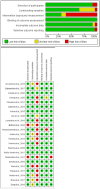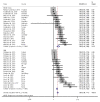Global relationship between parent and child obesity: a systematic review and meta-analysis
- PMID: 33781054
- PMCID: PMC8743427
- DOI: 10.3345/cep.2020.01620
Global relationship between parent and child obesity: a systematic review and meta-analysis
Abstract
Background: The growing prevalence of overweight and/or obese children is an important public health problem in both developed and developing countries. Although the association of obesity between parents and their children is well known, its underlying mechanisms are not well established.
Purpose: This meta-analysis examined parent-child (PC) relationships in obesity and identified factors such as world region and country income level that may influence this relationship.
Methods: We identified all related studies published between January 1, 2015 and May 31, 2020 by conducting a literature search using the MeSH terms "obesity," "overweight," "body mass index," "parent," "child," "associate," and "relate" in the PubMed database in English.
Results: The meta-analysis of 23 studies that reported an odds ratio (OR) for parent and child obesity associations found a significant association between parents and children who were overweight or obese (pooled OR, 1.97; 95% confidence interval, 1.85-2.10). A meta-regression analysis was used to examine the sources of interstudy heterogeneity. The association between parent and child obesity was higher in Asia than in Europe and the Middle East and higher in high-income countries than in middle-or low-income countries. In addition, a higher association between parent and child obesity was found when both parents were obese than when only the father or mother was obese. This study from multiple countries indicates a significant PC relationship in weight status that varies according to PC pair type, parent and child weight statuses, world region, and country income level.
Conclusion: These results demonstrate that the risk of childhood obesity is greatly influenced by parental weight status and indicate that parents could play an important role in preventing child obesity.
Keywords: Child; Obesity; Parent.
Conflict of interest statement
No potential conflict of interest relevant to this article was reported.
Figures






Comment in
-
Pediatricians must consider familial environment when diagnosing and managing childhood obesity.Clin Exp Pediatr. 2022 Jan;65(1):31-32. doi: 10.3345/cep.2021.00318. Epub 2021 Apr 19. Clin Exp Pediatr. 2022. PMID: 33872486 Free PMC article. No abstract available.
References
-
- World Health Organization . World health statistics 2020: monitoring health for the SDGs, sustainable development goals. Geneva (Switzerland): World Health Organization; 2020.
-
- World Health Organization . Geneva (Switzerland): World Health Organization; 2021. Overweight prevalence among children under 5 years of age (%) (JME) [Internet] [cited 2021 Jan 4]. Available from: https://www.who.int/data/gho/data/indicators/indicator-details/GHO/gho-j....
-
- World Health Organization . Geneva (Switzerland): World Health Organization; 2020. Obesity and overweight [Internet] [cited 2020 Aug 31]. Available from: https://www.who.int/news-room/fact-sheets/detail/obesity-and-overweight.
-
- Must A, Strauss RS. Risks and consequences of childhood and adolescent obesity. Int J Obes Relat Metab Disord. 1999;23 Suppl 2:S2–11. - PubMed
LinkOut - more resources
Full Text Sources
Other Literature Sources

